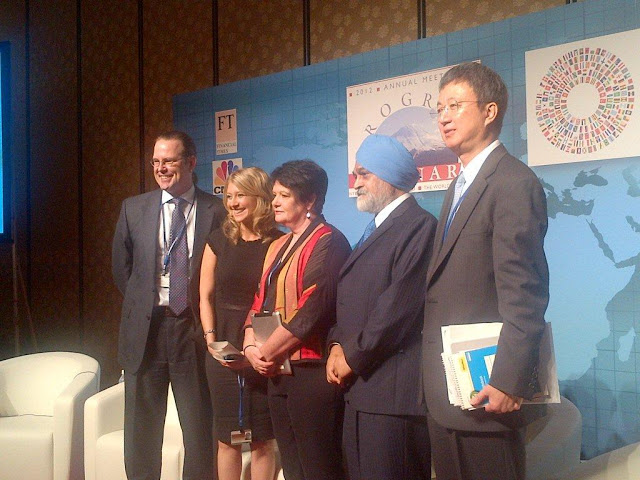Tuesday, October 16, 2012
Restoring Hope: Policy Options for Jobs & Growth
Sara Eisen of Bloomberg TV moderated a discussion on jobs and growth at the Tokyo annual meetings of the IMF and the World Bank. IMF Deputy Managing Director Zhu said that “in the near term, a growth strategy is the best jobs strategy”. Read his views here.
Sara Eisen of Bloomberg TV moderated a discussion on jobs and growth at the Tokyo annual meetings of the IMF and the World Bank. IMF Deputy Managing Director Zhu said that “in the near term, a growth strategy is the best jobs strategy”. Read his views here.
Posted by at 6:45 PM
Labels: Inclusive Growth
Are We Headed for Another Food Price Crisis?
My presentation at the Bank of America/Merrill Lynch conference in Tokyo is available here.
My presentation at the Bank of America/Merrill Lynch conference in Tokyo is available here.
Posted by at 6:10 PM
Labels: Energy & Climate Change
Wednesday, October 10, 2012
The global impact of the ‘food supply crunch’
From the FT:
Which countries will be worst affected by the sharp rise in global grains prices?
The International Monetary Fund, which has an interest in the question because it is usually a source of loans for countries that have run out of money, has studied the vulnerability of different regions to the jump in food prices due to the US drought.
In one section of its World Economic Outlook published on Monday, the fund analyses the effects of the “food supply crunch”.
While commodities traders – who are awaiting the US Department of Agriculture’s monthly forecasts on Thursday – may have already moved on from the US drought, higher prices are still a reality for consumers of wheat, corn and soyabeans. Despite a recent correction, prices for the three staples are still up 20-40 per cent year on year.
The IMF breaks down the issue into three sub-questions: which countries have low food inventories; which countries are most dependent on the global markets for their food supply; and which countries’ populations spend the largest proportion of their income on food.
The countries and regions at the most vulnerable end of the range for each of the categories are the most likely to suffer problems, the fund explains.
While China is a large importer of some foodstuffs (especially oilseeds), it would be able to withstand higher prices better than others because of its large stockpiles. At the other end of the scale, inventories of food commodities in the US have fallen well below historical norms, but food is a relatively small proportion of US consumer expenditure, therefore the country is less exposed.
It may not come as a complete surprise to learn which countries are most at risk. They are: the Caribbean and Central America, which are heavily reliant on corn imports and whose stocks are lower than during the 2007-08 food crisis; the Middle East and sub-Saharan Africa, which have relatively high import reliance and low inventories of wheat; and north Africa, where food accounts for about 40 per cent of final consumption.
Indeed, Morocco, which is forecast to import a record 4.5m tonnes of wheat this year, has already sought a $6.2bn precautionary loan from the IMF.
But the IMF says that the current situation is less severe than in 2007-08 as rice prices remain subdued, oil prices are not so high, and so far, there have not been widespread export restrictions.
Nonetheless, the fund concludes: “Countries should expect rising inflation and balance of payments pressures.”
From the FT:
Which countries will be worst affected by the sharp rise in global grains prices?
The International Monetary Fund, which has an interest in the question because it is usually a source of loans for countries that have run out of money, has studied the vulnerability of different regions to the jump in food prices due to the US drought.
In one section of its World Economic Outlook published on Monday,
Posted by at 10:09 AM
Labels: Energy & Climate Change
State of Global Labor Markets
My regular look at the global employment picture is available here.
My regular look at the global employment picture is available here.
Posted by at 1:32 AM
Labels: Inclusive Growth
IMF’s latest commodity outlook
The IMF just released this commodity markets review as part of its World Economic Outlook. The review provides the outlook for energy, metals and food markets.
It also discusses:
- the tight link between commodity prices and global demand;
- impact of Chinese growth on base metals;
- the supply-demand balance in oil markets;
- the vulnerabilities of countries to food price shocks.
We hope you find the review useful. The review is a public document and can be cited without prior permission. Questions and comments can be sent to rescommodities@imf.org
The IMF just released this commodity markets review as part of its World Economic Outlook. The review provides the outlook for energy, metals and food markets.
It also discusses:
- the tight link between commodity prices and global demand;
- impact of Chinese growth on base metals;
- the supply-demand balance in oil markets;
- the vulnerabilities of countries to food price shocks.
We hope you find the review useful.
Posted by at 1:24 AM
Labels: Energy & Climate Change
Subscribe to: Posts






